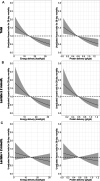Enhanced exclusive enteral nutrition delivery during the first 7 days is associated with decreased 28-day mortality in critically ill patients with normal lactate level: a post hoc analysis of a multicenter randomized trial
- PMID: 38245768
- PMCID: PMC10799529
- DOI: 10.1186/s13054-024-04813-6
Enhanced exclusive enteral nutrition delivery during the first 7 days is associated with decreased 28-day mortality in critically ill patients with normal lactate level: a post hoc analysis of a multicenter randomized trial
Abstract
Background and aims: Exclusive enteral nutrition (EN) is often observed during the first week of ICU admission because of the extra costs and safety considerations for early parenteral nutrition. This study aimed to assess the association between nutrition intake and 28-day mortality in critically ill patients receiving exclusive EN.
Methods: This is a post hoc analysis of a cluster-randomized clinical trial that assesses the effect of implementing a feeding protocol on mortality in critically ill patients. Patients who stayed in the ICUs for at least 7 days and received exclusive EN were included in this analysis. Multivariable Cox hazard regression models and restricted cubic spline models were used to assess the relationship between the different doses of EN delivery and 28-day mortality. Subgroups with varying lactate levels at enrollment were additionally analyzed to address the potential confounding effect brought in by the presence of shock-related hypoperfusion.
Results: Overall, 1322 patients were included in the analysis. The median (interquartile range) daily energy and protein delivery during the first week of enrollment were 14.6 (10.3-19.6) kcal/kg and 0.6 (0.4-0.8) g/kg, respectively. An increase of 5 kcal/kg energy delivery was associated with a significant reduction (approximately 14%) in 28-day mortality (adjusted hazard ratio [HR] = 0.865, 95% confidence interval [CI]: 0.768-0.974, P = 0.016). For protein intake, a 0.2 g/kg increase was associated with a similar mortality reduction with an adjusted HR of 0.868 (95% CI 0.770-0.979). However, the benefits associated with enhanced nutrition delivery could be observed in patients with lactate concentration ≤ 2 mmol/L (adjusted HR = 0.804 (95% CI 0.674-0.960) for energy delivery and adjusted HR = 0.804 (95% CI 0.672-0.962) for protein delivery, respectively), but not in those > 2 mmol/L.
Conclusions: During the first week of critical illness, enhanced nutrition delivery is associated with reduced mortality in critically ill patients receiving exclusive EN, only for those with lactate concentration ≤ 2 mmol/L.
Trial registration: ISRCTN12233792, registered on November 24, 2017.
Keywords: Critical illness; Enteral nutrition; Lactate; Mortality; Nutritional support.
© 2024. The Author(s).
Conflict of interest statement
The authors have no competing interests to declare.
Figures
References
-
- Gramlich L, Kichian K, Pinilla J, Rodych NJ, Dhaliwal R, Heyland DK. Does enteral nutrition compared to parenteral nutrition result in better outcomes in critically ill adult patients? A systematic review of the literature. Nutrition (Burbank, Los Angeles County, Calif) 2004;20(10):843–848. doi: 10.1016/j.nut.2004.06.003. - DOI - PubMed
MeSH terms
Substances
Grants and funding
LinkOut - more resources
Full Text Sources
Research Materials



